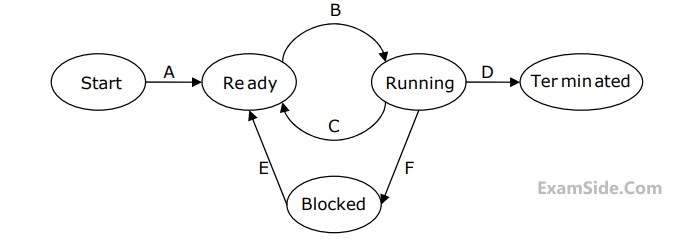1
GATE CSE 2009
MCQ (Single Correct Answer)
+1
-0.3
A CPU generally handles an interrupt by executing an interrupt service routine
2
GATE CSE 2009
MCQ (Single Correct Answer)
+2
-0.6
In the following process state transition diagram for a uniprocessor system, assume that there are always some processes in the ready state:


Now consider the following statements:
$$1.\,\,\,$$ If a process makes a transition $$D,$$ it would result in another process making transition $$A$$ immediately.
$$2.\,\,\,$$ $$A$$ process $${P_2}$$ in blocked state can make transition $$E$$ while another process $${P_1}$$ is in running state.
$$3.\,\,\,$$ The $$OS$$ uses preemptive scheduling.
$$4.\,\,\,$$ The $$OS$$ uses non-preemptive scheduling.
Which of the above statements are TRUE?
3
GATE CSE 2009
MCQ (Single Correct Answer)
+2
-0.6
The enter_CS() and leave_CS() functions to implement critical section of a process are realized using test-and-set instruction as follows:
I. The above solution to CS problem is deadlock-free
II. The solution is starvation free.
III. The processes enter CS in FIFO order.
IV More than one process can enter CS at the same time.
Which of the above statements is TRUE?
void enter_CS(X) {
while test-and-set(X) ;
}
void leave_CS(X) {
X=0;
}I. The above solution to CS problem is deadlock-free
II. The solution is starvation free.
III. The processes enter CS in FIFO order.
IV More than one process can enter CS at the same time.
Which of the above statements is TRUE?
4
GATE CSE 2009
MCQ (Single Correct Answer)
+1
-0.3
The coupling between different modules of a software is categorized as follows
$${\rm I}.\,\,\,\,\,\,\,\,\,\,\,$$ Content coupling
$${\rm II}.\,\,\,\,\,\,\,\,\,$$ Common coupling
$${\rm III}.\,\,\,\,\,\,\,$$ Control coupling
$${\rm IV}.\,\,\,\,\,\,\,$$ Stamp coupling
$${\rm V}.\,\,\,\,\,\,\,\,\,$$ Data coupling
Coupling between modules can be ranked in the order of strongest (least desirable) to weakest (most desirable) as follows.
$${\rm I}.\,\,\,\,\,\,\,\,\,\,\,$$ Content coupling
$${\rm II}.\,\,\,\,\,\,\,\,\,$$ Common coupling
$${\rm III}.\,\,\,\,\,\,\,$$ Control coupling
$${\rm IV}.\,\,\,\,\,\,\,$$ Stamp coupling
$${\rm V}.\,\,\,\,\,\,\,\,\,$$ Data coupling
Coupling between modules can be ranked in the order of strongest (least desirable) to weakest (most desirable) as follows.
Paper analysis
Total Questions
Algorithms
10
Compiler Design
1
Computer Networks
5
Computer Organization
4
Data Structures
2
Database Management System
5
Digital Logic
3
Discrete Mathematics
10
Operating Systems
10
Software Engineering
3
Theory of Computation
5
More papers of GATE CSE
GATE CSE 2025 Set 2
GATE CSE 2025 Set 1
GATE CSE 2024 Set 2
GATE CSE 2024 Set 1
GATE CSE 2023
GATE CSE 2022
GATE CSE 2021 Set 2
GATE CSE 2021 Set 1
GATE CSE 2020
GATE CSE 2019
GATE CSE 2018
GATE CSE 2017 Set 2
GATE CSE 2017 Set 1
GATE CSE 2016 Set 2
GATE CSE 2016 Set 1
GATE CSE 2015 Set 3
GATE CSE 2015 Set 2
GATE CSE 2015 Set 1
GATE CSE 2014 Set 3
GATE CSE 2014 Set 2
GATE CSE 2014 Set 1
GATE CSE 2013
GATE CSE 2012
GATE CSE 2011
GATE CSE 2010
GATE CSE 2009
GATE CSE 2008
GATE CSE 2007
GATE CSE 2006
GATE CSE 2005
GATE CSE 2004
GATE CSE 2003
GATE CSE 2002
GATE CSE 2001
GATE CSE 2000
GATE CSE 1999
GATE CSE 1998
GATE CSE 1997
GATE CSE 1996
GATE CSE 1995
GATE CSE 1994
GATE CSE 1993
GATE CSE 1992
GATE CSE 1991
GATE CSE 1990
GATE CSE 1989
GATE CSE 1988
GATE CSE 1987
GATE CSE
Papers
2023
2022
2020
2019
2018
2013
2012
2011
2010
2009
2008
2007
2006
2005
2004
2003
2002
2001
2000
1999
1998
1997
1996
1995
1994
1993
1992
1991
1990
1989
1988
1987